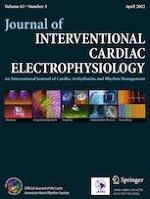Erschienen in:

26.11.2021
Association of device-measured physical activity with peak oxygen consumption measured by cardiopulmonary exercise testing in patients with cardiac implantable electronic devices
verfasst von:
Yasushi Wakabayashi, Masanori Kobayashi, Tomohide Ichikawa, Takashi Koyama, Hidetoshi Abe
Erschienen in:
Journal of Interventional Cardiac Electrophysiology
|
Ausgabe 3/2022
Einloggen, um Zugang zu erhalten
Abstract
Purpose
Cardiac implantable electronic devices (CIEDs) offer diagnostic information such as device-measured physical activity (PA). Peak oxygen consumption (VO2) measured by cardiopulmonary exercise testing (CPET) is the most objective variable showing exercise capacity. The purpose of this study was to investigate the relationship between these 2 variables.
Methods
We retrospectively studied consecutive patients with CIEDs undergoing CPET between April 1, 2018, and January 31, 2021. These patients were divided into 2 groups: patients with peak VO2 ≤ 14 ml/kg/min (low peak VO2 group) and those showing peak VO2 > 14 ml/kg/min (high peak VO2 group). The peak device-measured PA was compared between the 2 groups. The relationship between the peak device-measured PA and peak VO2 was also investigated.
Results
There were 50 and 51 patients in the low and high peak VO2 groups, respectively. The peak device-measured PA, which was expressed in units of hours/day, was significantly lower in the low peak VO2 group than in the high peak VO2 group (3.06, interquartile range [2.43–4.00] vs. 5.50, interquartile range [4.04–6.70] p < 0.01). The peak device-measured PA and peak VO2 showed a significant positive correlation (Spearman’s ρ = 0.53; p < 0.01). Furthermore, receiver operating characteristic curve analysis showed that a peak device-measured PA > 3.87 h/day could predict high peak VO2 (80.4%, sensitivity; 72.0%, specificity). In multivariate linear regression analysis, peak device-measured PA was an independent predictor of peak VO2 (regression coefficient, 0.61; 95% confidence interval, 0.33–0.89; p < 0.01).
Conclusions
Peak device-measured PA was significantly associated with peak VO2.











